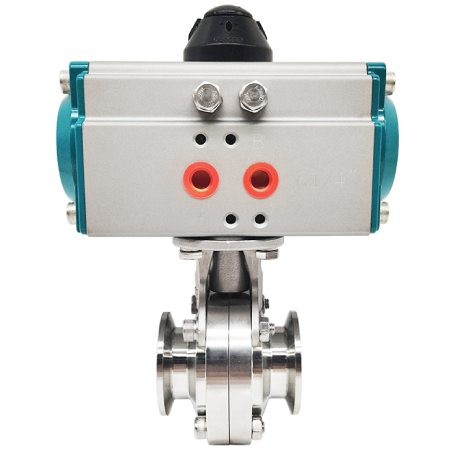- All
- Product Name
- Product Keyword
- Product Model
- Product Summary
- Product Description
- Multi Field Search
Views: 26 Author: Site Editor Publish Time: 2025-09-25 Origin: Site









In our last article, we introduced the most common butterfly valve body materials and how they affect strength and durability. But the body is only half the story.
 When it comes to sealing performance and service life, the valve seat (sealing ring) is just as critical. The seat material determines chemical resistance, temperature limits, wear resistance, and ultimately how long the valve will perform reliably in your system.
When it comes to sealing performance and service life, the valve seat (sealing ring) is just as critical. The seat material determines chemical resistance, temperature limits, wear resistance, and ultimately how long the valve will perform reliably in your system.
Here's a breakdown of the most widely used butterfly valve seat materials and their key properties:
![]() Features: Excellent acid resistance, safe and non-toxic, cost-effective, widely applied in potable water systems.
Features: Excellent acid resistance, safe and non-toxic, cost-effective, widely applied in potable water systems.
![]() Applications: Drinking water, wastewater, HVAC, low-temperature pipelines.
Applications: Drinking water, wastewater, HVAC, low-temperature pipelines.
![]() Common Valve Types: Centerline soft-seated wafer and lug butterfly valves.
Common Valve Types: Centerline soft-seated wafer and lug butterfly valves.
![]() Features: Outstanding oil and fuel resistance, good abrasion resistance, and strong performance with petroleum-based media such as fuels and natural gas.
Features: Outstanding oil and fuel resistance, good abrasion resistance, and strong performance with petroleum-based media such as fuels and natural gas.
![]() Applications: Oil, fuel, gas pipelines, compressed air systems.
Applications: Oil, fuel, gas pipelines, compressed air systems.
![]() Common Valve Types: Wafer and lug butterfly valves used in fuel and gas service.
Common Valve Types: Wafer and lug butterfly valves used in fuel and gas service.
![]() Features: Exceptional resistance to strong acids, alkalis, and solvents; withstands temperatures up to 180°C; long service life under demanding chemical conditions.
Features: Exceptional resistance to strong acids, alkalis, and solvents; withstands temperatures up to 180°C; long service life under demanding chemical conditions.
![]() Applications: Chemical processing, pharmaceuticals, corrosive industrial fluids.
Applications: Chemical processing, pharmaceuticals, corrosive industrial fluids.
![]() Common Valve Types: High-performance double-eccentric and triple-eccentric butterfly valves.
Common Valve Types: High-performance double-eccentric and triple-eccentric butterfly valves.
![]() Features: Wide operating temperature range (-60°C to 200°C), excellent elasticity, available in food-grade options for sanitary use.
Features: Wide operating temperature range (-60°C to 200°C), excellent elasticity, available in food-grade options for sanitary use.
![]() Applications: Food & beverage, pharmaceuticals, cosmetics, clean steam systems.
Applications: Food & beverage, pharmaceuticals, cosmetics, clean steam systems.
![]() Common Valve Types: Sanitary clamp butterfly valves, hygienic process valves.
Common Valve Types: Sanitary clamp butterfly valves, hygienic process valves.

![]() Features: Wide operating temperature range (-60°C to 200°C), excellent elasticity, available in food-grade options for sanitary use.
Features: Wide operating temperature range (-60°C to 200°C), excellent elasticity, available in food-grade options for sanitary use.
![]() Applications: Chemical plants, wastewater treatment, pipelines carrying corrosive fluids.
Applications: Chemical plants, wastewater treatment, pipelines carrying corrosive fluids.
![]() Common Valve Types: Lined butterfly valves, high-performance chemical service valves.
Common Valve Types: Lined butterfly valves, high-performance chemical service valves.
![]() Features: Capable of withstanding very high temperatures, abrasive media, and severe service conditions where soft seats fail. Performance depends on the specific alloy used.
Features: Capable of withstanding very high temperatures, abrasive media, and severe service conditions where soft seats fail. Performance depends on the specific alloy used.
![]() Applications: Steam pipelines, high-temperature gas systems, heavy-duty industrial service.
Applications: Steam pipelines, high-temperature gas systems, heavy-duty industrial service.
![]() Common Valve Types: Triple-eccentric butterfly valves, high-performance metal-seated valves.
Common Valve Types: Triple-eccentric butterfly valves, high-performance metal-seated valves.
| Seat Material | Key Features | Applications |
| EPDM | Acid resistant, non-toxic, cost-effective | Drinking water, HVAC, wastewater |
| NBR | Oil and abrasion resistance | Oil, fuel, gas, compressed air |
| FKM / Viton | Chemical resistance, heat resistant to 180°C | Chemicals, pharmaceuticals |
| Silicone (VMQ / SI) | Wide temp range, flexible, food-grade available | Food & beverage, pharma, clean steam |
| PTFE (Teflon) | Superior corrosion resistance, solvent-proof | Chemical plants, corrosive pipelines |
| Metal Seat | Withstands high temp & abrasive media | Steam, high-temp gas, heavy industry |
Choosing the right butterfly valve seat material is key to ensuring sealing reliability, service life, and cost-effectiveness.
At SLVCN, with over 30 years of valve manufacturing experience, we help global buyers select the most suitable seat material for their specific operating conditions. And if your project requires something unique, we can also customize butterfly valves with specialized seat options to meet your exact needs.